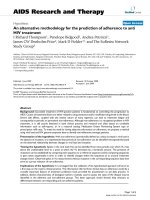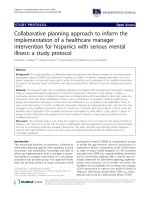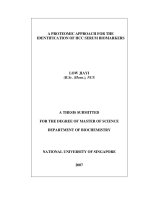Acceleration Methodology for the Implementation of Scientific App
Bạn đang xem bản rút gọn của tài liệu. Xem và tải ngay bản đầy đủ của tài liệu tại đây (513.65 KB, 50 trang )
Clemson University
TigerPrints
All Theses
Theses
5-2009
Acceleration Methodology for the Implementation
of Scientific Applications on Reconfigurable
Hardware
Phillip Martin
Clemson University,
Follow this and additional works at: />Part of the Computer Sciences Commons
Recommended Citation
Martin, Phillip, "Acceleration Methodology for the Implementation of Scientific Applications on Reconfigurable Hardware" (2009).
All Theses. 533.
/>
This Thesis is brought to you for free and open access by the Theses at TigerPrints. It has been accepted for inclusion in All Theses by an authorized
administrator of TigerPrints. For more information, please contact
ACCELERATION METHODOLOGY FOR THE IMPLEMENTATION OF
SCIENTIFIC APPLICATION ON RECONFIGURABLE HARDWARE
A Thesis
Presented to
the Graduate School of
Clemson University
In Partial Fulfillment
of the Requirements for the Degree
Master of Science
Computer Engineering
by
Phillip Murray Martin
May 2009
Accepted by:
Dr. Melissa Smith, Committee Chair
Dr. Richard Brooks
Dr. Walter Ligon
ABSTRACT
The role of heterogeneous multi-core architectures in the industrial and scientific
computing community is expanding. For researchers to increase the performance of
complex applications, a multifaceted approach is needed to utilize emerging
reconfigurable computing (RC) architectures. First, the method for accelerating
applications must provide flexible solutions for fully utilizing key architecture traits
across platforms. Secondly, the approach needs to be readily accessible to application
scientists. A recent trend toward emerging disruptive architectures is an important signal
that fundamental limitations in traditional high performance computing (HPC) are
limiting break through research. To respond to these challenges, scientists are under
pressure to identify new programming methodologies and elements in platform
architectures that will translate into enhanced program efficacy.
Reconfigurable computing (RC) allows the implementation of almost any
computer architecture trait, but identifying which traits work best for numerous scientific
problem domains is difficult. However, by leveraging the existing underlying framework
available in field programmable gate arrays (FPGAs), it is possible to build a method for
utilizing RC traits for accelerating scientific applications. By contrasting both hardware
and software changes, RC platforms afford developers the ability to examine various
architecture characteristics to find those best suited for production-level scientific
applications. The flexibility afforded by FPGAs allow these characteristics to then be
extrapolated to heterogeneous, multi-core and general-purpose computing on graphics
processing units (GP-GPU) HPC platforms. Additionally by coupling high-level
ii
languages (HLL) with reconfigurable hardware, relevance to a wider industrial and
scientific population is achieved.
To provide these advancements to the scientific community we examine the
acceleration of a scientific application on a RC platform. By leveraging the flexibility
provided by FPGAs we develop a methodology that removes computational loads from
host systems and internalizes portions of communication with the aim of reducing fiscal
costs through the reduction of physical compute nodes required to achieve the same
runtime performance. Using this methodology an improvement in application
performance is shown to be possible without requiring hand implementation of HLL code
in a hardware description language (HDL)
A review of recent literature demonstrates the challenge of developing a platformindependent flexible solution that allows access to cutting edge RC hardware for
application scientists. To address this challenge we propose a structured methodology
that begins with examination of the application’s profile, computations, and
communications and utilizes tools to assist the developer in making partitioning and
optimization decisions. Through experimental results, we will analyze the computational
requirements, describe the simulated and actual accelerated application implementation,
and finally describe problems encountered during development. Using this proposed
method, a 3x speedup is possible over the entire accelerated target application. Lastly we
discuss possible future work including further potential optimizations of the application
to improve this process and project the anticipated benefits.
iii
DEDICATION
I dedicate this to my mom Murray Martin and to everyone who helped along the
way.
iv
ACKNOWLEDGMENTS
Special thanks to: XtremeData for donating the development system to Clemson
University under their university partners program, the Computational Sciences and
Mathematics division at Oak Ridge National Laboratory and the University of Tennessee
at Knoxville for sponsoring the summer research at Oak Ridge National Laboratory that
lead to this paper, Pratul Agarwal, Sadaf Alam, and Melissa Smith for their involvement
with the research.
v
TABLE OF CONTENTS
Page
TITLE PAGE ....................................................................................................................i
ABSTRACT.....................................................................................................................ii
DEDICATION................................................................................................................iv
ACKNOWLEDGMENTS ............................................................................................... v
LIST OF TABLES........................................................................................................viii
LIST OF EQUATIONS .................................................................................................ix
LIST OF FIGURES .........................................................................................................x
CHAPTER
I.
INTRODUCTION .........................................................................................1
Role of FPGA based acceleration in HPC ...............................................1
Computation biology basics..................................................................... 3
II.
RESEARCH DESIGN AND METHODS .....................................................8
Research foundation.................................................................................8
Framework .............................................................................................12
Focused platform and application details .............................................. 14
III.
EXPERIMENTAL RESULTS..................................................................... 18
LAMMPS profiling................................................................................ 18
LAMMPS ported calculations ...............................................................19
LAMMPS ported communication..........................................................22
Discussion of Implementation challenges ............................................. 22
Results Hardware and Software Simulations......................................... 23
vi
Table of Contents (Continued)
Page
V.
CONCLUSIONS ........................................................................................28
VI.
FUTURE WORK ........................................................................................31
APPENDIX: Selected portions of LAMMPS Xprofiler Report .................................... 33
REFERENCES ..............................................................................................................38
vii
LIST OF TABLES
Table
Page
3.1
Summary of Single-processor LAMMPS Performance...............................18
3.2
Simulated Implementation Results .............................................................23
3.3
Hardware Implementation Results ..............................................................24
viii
LIST OF EQUATIONS
Equation
Page
1.1
Potential Energy Function .............................................................................3
3.1
Speedup ......................................................................................................22
ix
LIST OF FIGURES
Figure
Page
2.1
Bovine Rhodopsin Protein ............................................................................9
2.2
Parallel Scaling of LAMMPS ......................................................................10
2.3
ImpulseC Codeveloper Tool Flow............................................................... 12
2.4
XD1000 Development System ...................................................................15
2.5
Excerpt of Stage Master Explorer ...............................................................16
x
CHAPTER ONE
INTRODUCTION
Computer simulations are used extensively to accurately reproduce the process of
interest for the purpose of quantifying costs and benefits. Through the analysis of
different parameters and their effect on the recreated process, real world problems can be
explored. Weather, chemical, atomic, and biological processes are all areas that make
extensive use of computer simulations to develop new findings. The results from these
fields are, however, bound by two universal factors of computer simulation: effort
expended to create an efficient vs. accurate simulation model and the computational
power available to execute the simulation.
Historically, traditional computing solutions have aimed to leverage large-scale
distributed environments to boost computational power. This technique has in turn led to
the development of more complex and accurate models. As the model’s complexity
grows, the communication time needed in these distributed systems typically multiplies.
The inability to scale problems on these large-scale distributed platforms becomes a
critical impediment for new discoveries. To overcome this barrier, many industry vendors
are introducing heterogeneous platforms which pair traditional HPC hardware with
emerging non-RC architectures such as the Cell Broadband Engine™ and generalpurpose graphics processing units (GP-GPU) computing with Nvidia’s Tesla™ products.
Cell and GP-GPU architectures provide the a path to performance through on the use of
many-core. While the many-core approach does provide increased compute power and
internalized communication, a many-core approach is not an application specific solution.
The additional computational power may be underutilized since the underlying
architecture cannot be modified to specifically match the application. When the right
applications are matched to these architectures, they provided a very powerful computing
platform as demonstrated by Roadrunner, the world’s number one supercomputer as of
November 2008 is a heterogeneous platform combining AMD Opteron™ processors with
CellBE processors (Top500, Nov. 2008).
Another class of hybrid computing platforms that are both general purpose (can
be used on a wide variety of applications) and application specific (can be tailored
specifically for an application to achieve the best performance) is heterogeneous
reconfigurable computing. Over forty years since reconfigurable hardware was first
proposed, (Estrin and Turn, 1963), advancements in logic density and the availability of
hardware floating-point macros for reconfigurable platforms have garnered attention
from the scientific community. RC platforms with FPGAs are essentially an extreme
form of heterogeneous computing. The main difference between fixed multi-core (FMC)
or traditional homogeneous computing and FPGA implementations is that the underlying
architecture is not fixed. FPGAs allow the user to define the application-specific
architecture for solving problems in the hardware. Allowing the problem to guide the
underlying architecture is extremely efficient in terms of utilization and computational
density as only elements pertinent to the processing of the problem are included in the
design. The affect is a reduction in energy usage, space use, and often improved
communication versus a general-purpose processor.
2
The abilities of an Application Specific Integrated Circuit (ASIC) parallel that of
a FPGA. While an ASIC has similar efficiency as an FPGA, it is usually cheaper in large
quantities and slightly faster than a field programmable device since it does not have the
extra routing overhead present in FPGA devices. However, at the time of manufacture an
ASIC’s design is fixed which restricts its use requiring the user to change the design,
develop and manufacture a new ASIC for new features or computations. For example, a
custom ASIC for assisting in simulating supernova most likely will not be useful to a
simulation involving weather forecasting. Thus the reconfigurable nature of a FPGA
more then makes up for the slight performance tradeoff. Further, currently available
FPGAs provide capacities that are necessary for the computationally dense and complex
simulations currently conducted in many fields of research.
Biomolecular simulation is one area that is leading the advancements in
computational biology. The fundamental approach for most biomolecular simulators is
the use of Molecular Dynamics (MD). MD is a method for treating atoms as points with
both mass and charge thereby allowing the use of classical mechanics (IBM Corp., 2006)
to simulate the process. The forces on a single atom are split into two categories: bonded
and non-bonded interactions. The bonded interactions refer to the forces resulting from
the chemical bonds between the atoms in question. Non-bonded forces consist of the
electrostatic and Lennard-Jones potentials of the atoms. The charge and mass along with
the force of any bonds, which includes bond angles and bond torsions, are feed into the
equation of motion to solve for the trajectory of each atom over an extremely small unit
of time (Alam, et al, 2007; IBM Corp., 2006). Predicting the behavior of these atoms
3
requires a large number of force calculations that can be summarized as shown in the
overall potential energy function shown in equation 1.1:
E( potential) =
N N ⎛
A B ⎞ N N ⎛q q ⎞
f (torsion) + ∑∑⎜⎜ 12ij − 6ij ⎟⎟ +∑∑⎜⎜ i j ⎟⎟
rij ⎠ i=1 jtorsions
i=1 j
∑ f (bond) + ∑ f (angle) + ∑
bonds
angles
Equation 1.1: Potential Energy function used in computing particle trajectories
(Alam, et. al, 2007)
The first three chemical bond terms are constant throughout the simulation as the
number of bonds is kept constant (Alam, et. al, 2007). The latter two terms are the
summations of the van der Waals and electrostatic forces. These non-bonded terms
constitute a more significant portion of the computations than the bonded terms since the
number of atoms increases because the non-bonded terms are calculated between all other
atoms. This results in an O[N2]computations for a simulation with N atoms. Since all
atoms must communicate their current position to each other for the calculation of these
non-bonded interactions, scaling becomes a significant problem for large sets of atoms.
To overcome such challenges MD software packages typically include a ‘cutoff’
distance for non-bonded interactions allowing the users to control the complexity and to
improve algorithm parallelization (or performance) in traditional large-scale HPC
environments. This cutoff value is chosen at the discretion of the investigating scientist to
balance execution time with simulation accuracy. The accuracy achieved through the
selection of the cutoff value is problem dependent. A larger cutoff value results in a
longer but more accurate simulation since an infinite cutoff would result in the ideal
electrostatic force calculation from (Alam, et. al, 2007). Further, the cutoff value not only
4
determines the number of non-bonded computations, it also establishes the amount of
required communications for a parallel implementation since an atom must exchange the
distance and position of all other atoms within the cutoff distance.
Several custom computing projects, such as Blue Gene/L, Folding@Home, MDGRAPE, and others (Bader, 2004), were developed with the aim of improving the
performance of comprehensive MD simulations. However, MD-Grape and
Folding@Home are more application specific solutions and are not versatile enough to be
used in different problem domains. Blue Gene/L, on the other hand is more versatile but
weakly scales for problems that are not easily segmented into smaller sub-problems.
While achievements for MD simulations have been significant, all the platforms still
suffer from the basic substantial communication requirements of particle interactions
(Sandia National Laboratory, 2006; IBM Corp., 2006; Reid and Smith, 2005). These
requirements for numerous particle interactions, which are dominated by global
communication, have previously made MD simulation a difficult candidate for
application acceleration. Early studies of MD simulations on reconfigurable computing
platforms however, have demonstrated the performance potential of this class of systems.
NAMD, a MD simulator similar to LAMMPS, was ported to the SRC-6 platform
by Kindratenko and Pointer (Kindratenko and Pointer, 2006). In this paper the authors
use profiling to perform an analysis on the NAMD code and identify a specific function
that is appropriate for hardware acceleration. The function is then ported using SRC’s
MAP C development tool to perform assisted C to HDL translation. These
implementation steps are similar to the methods and research presented here, however,
5
the disadvantage of using the MAP C development tool is that it locks the user to a
particular platform, the SRC-MAPstations.
Scrofano also presents the acceleration of a MD simulation on a SRC MAPstation
(Scrofano, et. al, 2006). The focus here is on partitioning the application between
hardware and software. By correctly mapping certain tasks to the software and FPGA
hardware a 2x speedup is achievable. In choosing to keep at least some calculations in
software Scrofano is able to preserve the ability to flexibly add and remove tasks. The
main drawback of this work in comparison to the work presented here, is the choice to
develop and use a custom MD kernel that may not be amenable to applications in
widespread use by the scientific community.
Herbordt and Vancourt present a more focused view on the use of specialized MD
techniques that can be implemented to extract higher performance from FPGAs
(Herbordt and VanCourt, 2007). The twelve methods presented in the paper underscore
the need for development of hardware code that is portable across platforms while
maintaining acceleration for a family of software instead of more targeted, specialized
approaches. These key points were an inspiration for implementing the two large
communication buffers used in this research for shared memory to help hide signaling
overhead.
To address these limitations a flexible methodology is proposed for leveraging
recent advances in RC platforms and software development environments to accelerate
scientific applications. By using FPGAs to remove computational loads from the host
systems, we propose to redirect large portions of communication currently on the
6
network to internal buses such as the AMD’s HyperTransport™ bus. The additional
computational power per node will also result in a reduced number of physical compute
nodes required to achieve the same runtime performance, which leads to other cost and
power savings. Furthermore, the use of HLL languages for development is emphasized as
a means to allow application scientists to utilize the performance of cutting-edge RC
platforms.
We have shown that there is a need for studying and developing a method for
flexible implementation of a scientific application that maintains platform independence.
This methodology should address the characteristics (computation and communication
profiles) of the targeted application and utilize appropriate tools for producing a hardware
accelerated program that is portable. The next chapter will discuss the LAMMPS
software, our chosen hardware platform and the HLL-to-HDL development environment
that allows scientists easier access to RC hardware.
7
CHAPTER TWO
RESEARCH DESIGN AND METHODS
To harness the increased computational power provided by reconfigurable
computing (RC) hardware an innovative technique is essential for overcoming the
challenge of porting application code written in a high-level language to a hardware
description language (HDL). Further, traditional methods such as hand porting required
complex modifications to application codes for each potential target platform. These
modifications have been a significant hindrance to the adoption of reconfigurable
computing architectures. Even preliminary questions such as ‘what algorithm would
benefit most from porting to an RC platform’ and ‘how to accurately estimate the
performance gain without an actual implementation in hardware’ seem daunting when
combined with the user-defined nature of FPGAs.
Using a production-level molecular dynamics software package, LAMMPS
(Large-scale Atomic/Molecular Massively Parallel Simulator) developed by Sandia
National Laboratory (Sandia National Laboratory, 2006) we seek to develop and
demonstrate a framework for accelerating scientific applications in RC environments.
LAMMPS’s prevalence in the computational biology field, well defined mathematical
computations, and implementation in the C++ language make it a desirable candidate
application for demonstrating the methods used to accelerate this and similar classes of
scientific applications.
8
To measure the performance gain against multiple systems we intend to use the
Rhodopsin protein benchmark. In detail the Rhodopsin protein benchmark comprises a
simulation of the interactions of 32,000 atoms contained in the Bovine Rhodopsin protein
in a solvated lipid bilayer (Sandia National Laboratory, 2007). In simple terms the protein
is trapped within a layer of lipid (fat) with water as the solvent surrounding both the top
and bottom of the lipid layer. Figure 2.1 shows a ribbon view of the protein. The
Rhodopsin protein benchmark is an inbuilt simulation provided with the LAMMPS
software as a means for a standard measure of system performance. This benchmark is
the most complex of the inbuilt LAMMPS simulations and a more detailed comparison is
given in chapter three. Additionally the development team has compiled a list, available
at of other traditional HPC platforms in which
performance data was collected for comparison.
9
Figure 2.1: Bovine Rhodopsin protein shown in ribbon form with random coloring to
better show the alpha helices, the protein does not contain any beta sheets.
In a performance test on the IBM Blue Gene/L, LAMMPS was shown to be the
most parallelizable algorithm - scaling relatively efficiently to 4096 processors (IBM
Corp., 2006). As figure 2.2 shows, scaling beyond 4096 processors results in the overall
communication overhead outweighing the computational benefits – diminishing returns.
Overcoming this scaling limitation, present in many of the currently available highperformance computing platforms, is the long-term goal of this research.
Figure 2.2: Parallel scaling of LAMMPS on Blue Gene (1M System: 1-million atom
scaled Rhodopsin protein, 4M System: 4-million atom scaled Rhodopsin protein) (IBM
Corp., 2006)
10
As in the early days of computing, application porting to early RC environments
required the entire program functionality to be hand-coded in HDL. This costly
development method is still in use today due to the ability to produce the most
computationally efficient result with any other available development method. The result
is dependent, however, on several factors: how familiar the developer is with the
intricacies of both the hardware platform and software to be ported and the developer’s
proficiency with HDL. Hardware vendors have responded to this challenge with
intellectual property (IP) libraries that implement certain specific and sometimes limited
functionalities, such as floating-point libraries. These IP libraries however are often
black-boxes, their implementation is completely hidden to the application developer.
Additionally the IP library is almost always tied to that vendor’s hardware making cross
platform support difficult at best. These limitations have driven a recent push toward
complete tool suites that build upon the IP libraries of each hardware vendor to form a
universal SDK for programming RC platforms through the use of HLL abstraction. Of
these HLL-to-HDL suites, ImpulseC was chosen for this research due to its support for a
number of RC platforms of interest, namely the XtremeData XD1000, DRC DS1000 and
Nallatech H101 PCI-X board.
ImpulseC’s CoDeveloper tool suite (ImpulseC Corp., 2008) allows programmers
to conduct application development in a familiar language, C, without requiring an
extensive hardware background or familiarity with obtuse HDL languages. Further,
programmers can optionally cross-develop for multiple platforms with minimal changes.
11
Various project settings control which platform the CoDeveloper tool suite targets
through specific generation macros. Fig. 2.3 displays an overview of the development
flow within the ImpulseC toolset.
Figure 2.3: ImpulseC Codeveloper tool flow (ImpulseC Corp., 2008)
In the RC development for LAMMPS, which is implemented in C++, we make
use of the ImpulseC development environment for easy integration between RC code and
existing software portions of the application. After modifying select portions of the
original LAMMPS source code with ImpulseC to target the reconfigurable hardware, it is
possible to port these portions of the algorithm to multiple hardware platforms. One of
our objectives is to examine and document the capabilities of the XD1000 with
LAMMPS as a potential platform of study for the scientific community. Later studies will
take advantage of the portability of code developed in ImpulseC to target other RC
platforms including the DRC DS1000 (DRC Computer Corp., 2008).
12
The advantage of using a C-to-HDL development method, as (Kilts, 2007)
mentions, is that these applications have the ability to compile and run against other C
models. More importantly Kilts states that, “One of the primary benefits of C-level
design is the ability to simulate hardware and software in the same environment.” In this
implementation we extensively use both capabilities to reduce complexity and fast-track
the development on new platforms.
The ImpluseC CoDeveloper tool suite includes a C-to-VHDL (or Verilog)
compiler and development environment. This compiler permits the creation of
communication channels, buffers, and signals through simple function calls from the
high-level language (HLL) environment (Pellerin and Thibault, 2005). Effectually, the
abstraction gained from using HLL interfaces enables two things. Most importantly the
developer is not required to have specific hardware design knowledge to generate results.
An additional benefit is the user’s code is now portable since any platform specific code
is now hidden below these universal function calls making the functionality transparent to
the developer.
The development environment in the tool suite also assists the programmer with
system integration and includes several options for debugging and simulating application
codes in software for a variety of reconfigurable computing platforms. The built-in
simulator’s capabilities include simulating the buffers, communication channels, FPGA
hardware, and host program during run-time as well as logging options useful for
debugging. In detail the CoDeveloper tool suite supports the integer math functions:
addition, subtraction, multiplication, division, and number comparisons. Similar
13
operations in floating-point are additionally supported to an extent. Issues relating to the
extent of implementation surrounding these floating-point operations are addressed in the
discussion of the results.
There are two main methods for producing VHDL or Verilog from target code
segments in the CoDeveloper tool suite: shared memory or a stream interface approach.
A stream interface allows a direct software-to-hardware channel that can be uni- or bidirectional. The main benefit of a stream approach is the simplified signal interface to
synchronize producer and consumer functions when accessing data exchanged between
the host processor and FPGA. The more complex shared memory approach however
usually allows for higher data transfer bandwidth. All reads and writes for shared
memory are performed directly to the FPGA’s internal BRAM. The drawback with this
method is the need for the programmer to explicitly manage the synchronization of the
memory accesses in C through the use of signals. While ImpulseC’s development tools
are able to provide transparent communication, the bandwidth and latency is still
determined by the platform hardware.
The target platform is XtremeData Inc.’s XD1000 which has an Altera Stratix II
FPGA module that is an AMD Opteron™ replacement (XtremeData Corp., 2007). The
ability to place an FPGA module into any open Opteron socket allows the FPGA to
leverage the existing cooling, power and communication infrastructure. Further, the
ImpulseC SDK is able to take advantage of AMD’s HyperTransport™ bus present in the
XD1000 system to provide the tightly-coupled communication interface necessary to
14









